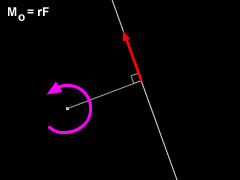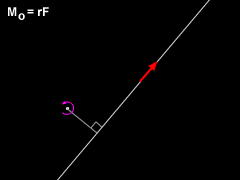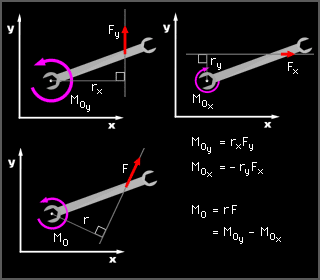| Ch 4. Moments/Equivalent Systems | Multimedia Engineering Statics | ||||||
|
Moment 2-D Scalar |
Moment 3-D Scalar |
Moment 3-D Vector |
Couples and Equiv. System | Distributed Loads, Intro | |||
| Moment of Force: 2-D Scalar | Case Intro | Theory | Case Solution | Example |
| Chapter |
| 1. Basics |
| 2. Vectors |
| 3. Forces |
| 4. Moments |
| 5. Rigid Bodies |
| 6. Structures |
| 7. Centroids/Inertia |
| 8. Internal Loads |
| 9. Friction |
| 10. Work & Energy |
| Appendix |
| Basic Math |
| Units |
| Sections |
| eBooks |
| Dynamics |
| Fluids |
| Math |
| Mechanics |
| Statics |
| Thermodynamics |
| ©Kurt Gramoll |
|
|
||
| Moment of a Force |
||
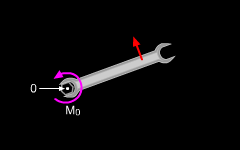 Moment of a Force
|
The moment of a force about a point is a measure of the tendency of the force to rotate a body about that point. The body does not necessarily have to rotate about that point, but the moment defines how the force is trying to rotate the body. A good example of a moment is when a force applied is applied to a wrench. The wrench may not actually turn, but the force generates a turning force (i.e. moment) around the bolt. Moments are often referred to as torques, and the terms can be used interchangeably. In scalar notation, a moment about a point O is Mo = r F Here F is the magnitude of the force and r is the perpendicular distance to the line of action of the force. The orientation of the moment is in the same direction as the rotation of the body if the body were allowed to rotate. A moment can be symbolized as a curved vector around the rotation point. If a force is applied at the point O or the line of action of the force passes through point O, then the moment about point O is zero, and the force has no tendency to rotate the body about that point.
|
|
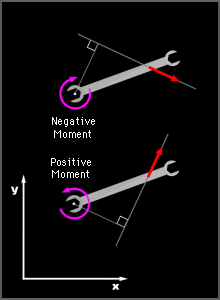 Moment Direction and Sign |
|
|
| Principle of Moments |
||
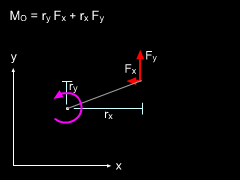 Moment Components |
The principle of moments, which is also referred to as Varignon's theorem, states that the moment of a force about a point is equal to the sum of the moments of the force's components about the point. Therefore, if the components of a force are known, it may be simpler to determine the moment of each component and then add them. |
|
Practice Homework and Test problems now available in the 'Eng Statics' mobile app
Includes over 500 free problems with complete detailed solutions.
Available at the Google Play Store and Apple App Store.

